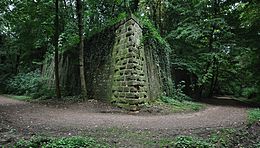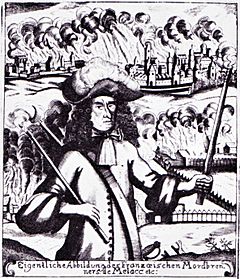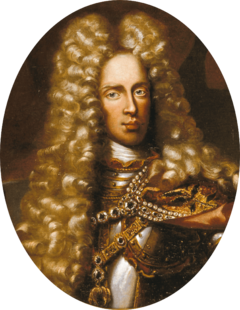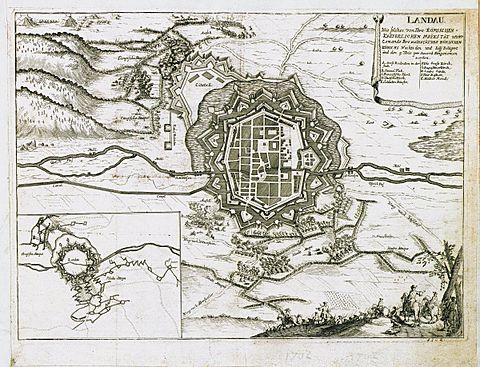Siege of Landau (1702) facts for kids
Quick facts for kids Siege of Landau (1702) |
|||||||
|---|---|---|---|---|---|---|---|
| Part of War of the Spanish Succession | |||||||
 Parts of Landau's defenses from the 1680s still exist. |
|||||||
|
|||||||
| Belligerents | |||||||
| Commanders and leaders | |||||||
Savoy † |
|||||||
| Strength | |||||||
| 46,000 | 4,335 | ||||||
| Casualties and losses | |||||||
| 2,865 | at least 1,700 | ||||||
The Siege of Landau was a major battle that happened from June 16 to September 12, 1702. It was part of a bigger conflict called the War of the Spanish Succession. An army from the Holy Roman Empire, led by Louis William, Margrave of Baden-Baden, surrounded the strong fortress city of Landau in Germany.
The city was defended by French soldiers under Ezéchiel du Mas, Comte de Mélac. Even though the French fought very bravely, they had to give up after being surrounded for three months. This victory for the Holy Roman Empire took place in Landau, which is in the Rhineland-Palatinate region of Germany.
Contents
What Led to the Siege?
Landau used to be a free city in the Holy Roman Empire. But after a big war in 1648, it became part of France. A famous French military engineer named Sébastien Le Prestre de Vauban completely rebuilt the city's defenses starting in 1688. These new walls and forts made Landau very strong.
In 1689, a fire destroyed much of the city. This allowed French engineers to redesign the streets. Later, in 1700, another engineer added a special fort called the Crownwork on a hill. This gave Landau even more protection. The city was also split by the Queich River, and its defenses included moats and a clever system to control water levels.
The War Begins
The War of the Spanish Succession started in 1701 in Italy. The Holy Roman Empire and its allies formed the Grand Alliance in September 1701. This group wanted to stop France from becoming too powerful. The Grand Alliance included the Holy Roman Empire, England, the Dutch Republic, and many German states. France had allies like the Electorate of Bavaria.
In early 1702, Louis William, Margrave of Baden-Baden was put in charge of the Imperial troops along the Rhine River. In April, his army crossed the Rhine and moved south towards Landau. They set up camp and prepared for war, even before war was officially declared in May.
Who Fought in the Siege?
The Imperial army, led by Louis of Baden, was very large. It had about 25,900 foot soldiers and 10,920 cavalry (soldiers on horseback). Many different parts of the Holy Roman Empire sent troops, including soldiers from the Palatinate, Würzburg, and Swabia. By June, Louis's army grew to about 32,000 foot soldiers and 14,000 cavalry.
The French army, led by Marshal Nicolas Catinat, was much smaller. They couldn't directly fight the large Imperial force. Instead, Catinat sent more soldiers and supplies to Landau to help defend it.
Defenders of Landau
Landau was defended by Lieutenant General Ezéchiel du Mas, Comte de Mélac, who was 72 years old. He commanded a garrison of about 4,095 foot soldiers and 240 cavalry. Mélac was known for destroying parts of the Palatinate region in an earlier war. His forces included several infantry regiments and a special company of soldiers.
Even though the city was surrounded, some French officers tried to sneak in to join their units. One officer, d'Amigny, successfully got into the city disguised as a peasant.
How the Siege Unfolded
On June 15, 1702, Louis of Baden moved his entire army to Landau. They set up six camps around the fortress. The siege officially began on June 16. The Imperial army planned three main attacks on different parts of the fortress. The French defenders fired heavily with their cannons, making it dangerous for the Imperial soldiers digging trenches.
Bringing in Big Guns
At first, Louis's army didn't have large siege cannons. They used smaller field cannons, which didn't do much damage to the strong fortress walls. So, they asked other cities for help. Cities like Augsburg and Frankfurt sent heavy cannons and gunpowder. The first big cannons arrived on June 21.
With these new weapons and expert gunners, the Imperial army began a heavy bombardment of Landau on July 2. They eventually used 46 mortars and 114 cannons, including very powerful ones.
Fighting and Digging
The French defenders often launched surprise attacks at night to try and destroy the Imperial trenches. Mélac himself led some of these attacks. The Imperial army kept digging closer to the fortress walls. They also had to deal with the French flooding the moat.
The French also used hidden mines. When Imperial soldiers attacked an outer defense, the French would light a fuse and try to blow up the attackers as they retreated. To counter this, the Imperial engineers dug their own tunnels to find and disarm the French mines.
On July 26, Archduke Joseph, who would later become the emperor, arrived at Landau. He took official command of the army, but Louis of Baden still made all the important decisions. Joseph even visited the dangerous siege lines and helped aim some cannons.
The Final Attacks
By early August, the Imperial army was very close to the main defenses. On August 6, a mine exploded, creating a gap in the outer wall. Imperial troops immediately attacked during a severe storm and gained a foothold. At the same time, other Imperial soldiers attacked the Crownwork, another strong fort. Both sides suffered many casualties. Sadly, on August 16, the Count of Soissons, an Imperial commander, was killed by a shell.
The French inside Landau started running out of supplies. They melted down lead from windows to make bullets. Food was scarce, and Mélac even melted his personal silver to pay his soldiers. By this time, only about 1,800 French soldiers were still able to fight. Many were dead or in the hospital.
King Louis XIV of France wanted his general, Catinat, to help Landau. But Catinat said his army was too small. A message finally reached Mélac, telling him no help was coming.
By August 30, the Imperial army had set up powerful cannons very close to the fortress. They blasted the walls, creating a large hole by September 8. The Crownwork was almost completely destroyed. Mélac decided to abandon the Crownwork on September 5, leaving only a small group of soldiers. The Imperial army attacked the Crownwork on September 8, not knowing it was mostly empty. They suffered heavy losses from a final mine explosion set by the few remaining French defenders.
Surrender of Landau
On September 9, Mélac held a meeting with his officers. They decided to surrender the fortress. Mélac sent an officer to negotiate the terms. On September 10, Louis of Baden and Mélac signed the surrender agreement. Louis praised Mélac for his strong defense.
The French survivors were allowed to march out with their drums playing and flags flying. They could keep their personal weapons and some cannons. On September 12, the French soldiers began their journey home.
What Happened Next?
After taking Landau, the Imperial army found that most of the French cannons were ruined. An Imperial garrison of six battalions was placed in Landau to guard it. Archduke Joseph visited the city before returning home. The people of Landau had suffered greatly, with many houses destroyed.
In September, the Electorate of Bavaria joined the war on France's side. This changed the balance of power. Louis of Baden had hoped to conquer more French territory, but instead, he had to move his army to protect German states. The French sent a new army under Claude Louis Hector de Villars. On October 14, 1702, Villars defeated Louis of Baden at the Battle of Friedlingen.
In the years that followed, the Imperial army faced financial problems. Louis of Baden complained that his troops weren't paid properly. Meanwhile, the French continued to gain ground. The stage was set for the French to try and take Landau back from the Imperial army.






